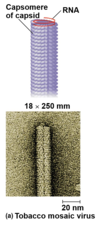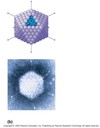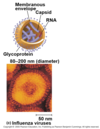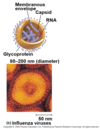Viruses Flashcards
What is a bacteriophage?
These are viruses that can infect and take over bacteria.
Why is E. coli and its viruses referred to as a model system by researchers?
They are used by researchers to reveal broad biological principles.
What are bacteria classified as? Are they smaller than eukaryotes? How do viruses stack up to bacteria?
Bacteria are prokaryotes, that are much smaller and simpler than eukaryotes.
Viruses are even small and even simpler than prokaryotes.

Did scientists indirectly discover viruses before they could see them?
YES
How did Beijerinck initially indirectly discover the existence of viruses?
Tobacco mosaic disease of tobacco plants was used.
Sap was extracted from infected plant and sent through a filter known to trap bacteria, ruling out that possibility.
The filtered sap was introduced to a new plant and the plant eventually became infected.
This step was repeated and the plants continued to show infection. This rules out the possibility of the infection being caused by a toxin because eventually the toxin would decrease in concentration enough to now affect the plant.
THIS MEANS THAT IT MUST BE SOMETHING MUCH SMALLER THAN A BACTERIA THAT CAN REPLICATE.

Who and how was Beijerincks proposal confirmed?
By wendell Stanley by crystallizing the infectious particle that is now known as tobacco mosaic virus.
Are viruses cells?
NO
What is a virus? What does a virus consist of?
A virus is a very small infectiour particle that consists of nucleic acids enclosed in a protein coat (capsid). Some of them have a membraneous envelope covering the protein coat.
What makes up the capsid?
Small protein subunits called capsomeres, usually their is very little variety of the proteins that make up the capsid.

What are two shapes that the capsid can take on in a virus described in the book?
Helical - Capsomere forms alpha helix that is compressed into rod shape.
Icosahedral - polyhedral shape with 20 facets.
Capsid structure?

Helical
Capsid structure?

Icosahedral
What are the two types of genomes a virus consists of? Can they be either single or double stranded?
DNA or RNA
Yes both can either be single stranded or double stranded
So if a virus has DNA it is a DNA virus and if it has RNA it is an RNA virus?
YES
How many genes do the smallest viruses have? What about the largest?
3
several hundred to a thousand
NUMBER OF GENES VARIES.
What is a capsid?
This is a protein shell that encloses the viral genome that consists of protein subunits called a capsomere.
Do some viruses have a membraneous (Viral) envelope? What are they derived from?
YES
They are derived from the host cell membrane, and consist of both viral and host cell molecules.

What is the purpose of the membraneous (viral) envelope?
These help the virus infect the host.








